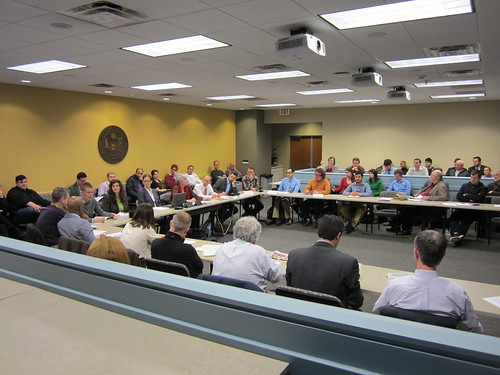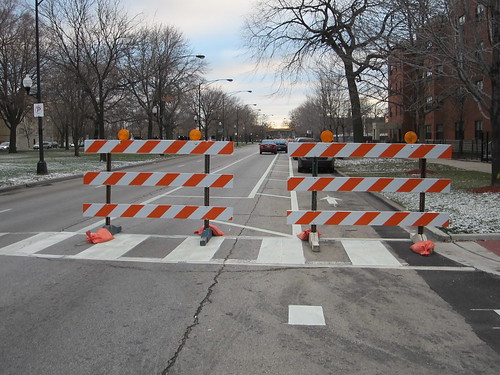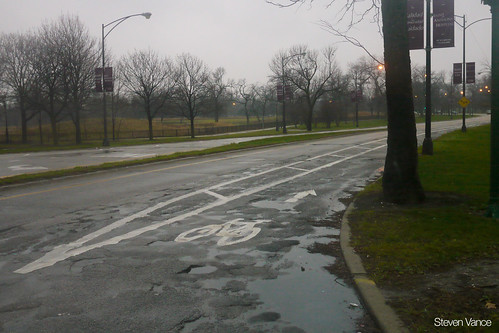Highlights From the March Mayor’s Bicycle Advisory Council Meeting
10:20 AM CDT on March 15, 2013
The quarterly Mayor’s Bike Advisory Council meetings, held on the 11th floor of City Hall, are an excellent way to get up to speed on local cycling initiatives. At Wednesday's meeting Mike Amsden, who manages the Chicago Department of Transportation’s bikeways projects, discussed the agency's proposal to build protected bike lanes on Milwaukee Avenue between Kinzie and Elston avenues, which would require parking removal. New on-street bike parking corrals, bike share kiosks and “People Spot” parklets might be part of the plan. “There are quite a few bars and restaurants, so we’ll be making sure, hey, if they’re losing a parking space they get a nice bike corral or a bike share station,” said CDOT Commissioner Gabe Klein.
Klein acknowledged that not everybody who currently commutes on Milwaukee is going to be excited about riding in protected lanes. “For the most part we’re building protected lanes for the ‘8 to 80’ set but the group that’s using Milwaukee is different. And so we have to be prepared for the fact that many people, like the guy on the fixie, may not use the bike lanes. We’re going to have to think about that in the design.”
The meeting began with a discussion of the department’s recent re-organization. Janet Attarian, head of CDOT’s new “complete streets group,” said the new structure should make it easier for staffers working on biking, walking and transit projects to plan and implement changes that help many modes at once, instead of doing them piecemeal.
That should make it easier to sell street improvements to residents, and help prevent situations where facilities like protected bike lanes are installed and then downgraded to buffered lanes after opposition from locals, as was the case on Independence Boulevard last year. “For the most part we’ve done pretty well,” said Amsden. “But there were definitely some situations where there were concerns about community outreach. We think this will be a great way to mitigate that, by showing the benefits to everybody involved.”
MBAC community representative Michelle Stenzel had a series of questions about bikeways, which she had elicited from local cyclists on The Chainlink online forum. She noted that bike lanes on Wells Street has been badly torn up between Chicago and North avenues since last fall and asked for an ETA on the repairs. Amsden responded that the street had been opened for a water project, it will be resurfaced this spring, and buffered lanes should be striped by June.
Stenzel noted that in the recent past some new bike lanes have been striped on terrible pavement and asked if that practice is going to be discontinued. “There have definitely been a few situations where we put something in on pretty bad-shape roadway,” Amsden responded. “Sacramento Boulevard comes to mind. We are trying to resurface that roadway but the timing didn’t work out so well.” He promised in the future, “If a road’s in really bad shape we’re not going to stripe anything.”
When Stenzel asked about plans for plowing the protected lanes, she said CDOT has been doing a decent job of clearing the lanes this winter, but adjacent building maintenance crews often push snow from their sidewalks into the lanes after they’ve been plowed. Klein said his crews have had to plow the same lanes twice because of this, and outreach to building managers might be a solution next year. He also acknowledged that the Dearborn Street two-way protected bike lanes have divots that have been filling up with water and ice this winter and said CDOT will be patching these in the near future.
Cyclists at the meeting noted that there have been issues with cars driving in the Dearborn lanes. “In terms of vehicles in the lanes we have to experiment with the right number of poles,” Klein said. “It’s nice that we’re not using concrete [bollards] yet which allows us to make changes. We talked about putting a delineator right at the entrance [to the bike lanes at each intersection.] We decided to try it without that and see if we need it. I think you’ll see some changes next year.”
Stenzel asked about the possibility of separating the Dearborn lanes from cars with concrete curbs. “That’s something that we definitely want to do,” Amsden replied. “We need to figure out the best way to fund it and we’re brainstorming about how to do that. It’s a lot more expensive, but we want to try to get them in as soon as we can.”
There have been problems with pedestrians crossing the Dearborn lanes against the light and standing in the lanes while waiting for the walk signal, Stenzel noted. Amsden said CDOT will be repainting “Look” stencils on the street, adding green pavement at intersections, and doing outreach via the Bicycling Ambassadors. He added that as more people start using the lanes this spring, peds will become more aware of them. “It’s a learning curve, but it hopefully will get better.” He added that CDOT is installing non-slip plates on the Dearborn bridge “as we speak,” and the surprisingly complicated project, being done by a crew on a barge in the river, should be done by the end of next week.
Ben Gomberg, who is coordinating the launch of Chicago’s 4,000-vehicle bike-share system, provided an update. CDOT awarded the bike-share contract to Alta Bicycle Share in January. Gomberg introduced Kansas Waugh, deputy general manager for Alta’s Chicago operations, and Ed Inlow, the new general manager, a Chicagoan who was hired just two days earlier. “We’re gung ho about getting going,” Waugh said.
Gomberg said he hopes to launch the system this summer with 3000 bikes within an area roughly bounded by Montrose Avenue, Damen Avenue, 43rd Street, and Lake Michigan. The remaining thousand vehicles would be added the following year. The team is almost done siting the first 300 stations, and the locations are currently with the relevant aldermen for their review and suggestions. “I hope to have that review finished in a couple weeks time,” Gomberg said. “Once we do that we’ll have engineering plans prepared.”
Near the end of the meeting there was a lively discussion, involving a couple of lawyers present, on the legality of riding outside a protected bike lane when one is provided. We’ll cover that topic in detail in a post this afternoon.
In addition to editing Streetsblog Chicago, John writes about transportation and other topics for additional local publications. A Chicagoan since 1989, he enjoys exploring the city on foot, bike, bus, and 'L' train.
Stay in touch
Sign up for our free newsletter
More from Streetsblog Chicago
Johnson appoints one West Side pastor to CTA board, then nominates another West Side pastor for RTA board
Supporters argue that, despite his lack of transit expertise, Ira Acree’s social justice experience and political connections could be an asset for the RTA board.
Today’s Headlines for Thursday, April 26
The de-facto ban on riverwalk biking is back. What should we do about it?
In the short term, new signage is needed to designate legal areas for cycling on the path. In the long term CDOT should build the proposed Wacker Drive protected bike lane.








